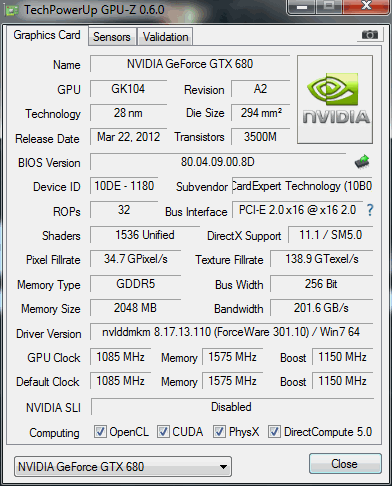Index
Overclocking and GPU Boost are closely related. Namely, GPU Boost is a hardware implemented feature that cannot be disabled. GPU Boost operates completely autonomously with no game profiles and no intervention required by the end user, providing an instant performance boost to gamers. This feature monitors important operation parameters and calculates optimum GPU clocks. However, although it may seem as an overclocking limiter, overclocking is still flexible enough. In fact, GTX 680’s OC potential isn’t half bad. Note that reference GTX 680 cards run at 1006MHz, whereas the Phantom’s GPU is at 1085MHz.
Gainward GTX 680
Gainward GTX 680 Phantom
GPU Boost is similar to Intel’s Turbo Boost. If an app or game you started doesn’t overburden the GPU, i.e. doesn’t max out the TDP and thermals, then GPU Boost will up the clock from the Base clock to Boost clock and thus improve performance.
Shader clock is something that Nvidia abandoned with Kepler, but now we have other two clocks worth noting – “Base Clock“ and “Boost Clock“.
The Boost Clock is the average clock frequency the GPU will run under load in many typical non-TDP apps that require less GPU power consumption. On average, the typical Boost Clock provided by GPU Boost in Geforce GTX 680 is 1058MHz, an improvement of just over 5%. The Boost Clock is a typical clock level achieved while running a typical game in a typical environment.
However, in many cases the GPU will have additional power headroom available and will automatically increase the Boost Clock even higher than 1058MHz. As long as the GPU remains under its power target, GPU Boost will seamlessly increase the GPU Clock. We measured maximum GPU clock of 1110MHz on Gainward’s reference GTX 680 while Phantom’s max was 1189MHz.
Playing Crysis 2 at reference Base clock resulted in 13 different GPU clocks, starting from 1006MHz and ending with 1110MHz 1006/1019/1032/1045/1058/1071/1054/1097/1110MHz). So, overclocking Kepler GPUs won’t provide stable and fixed OC clocks, since the GPU Boost feature produces a range of OC clocks.
While playing at 2560x1600, we noticed that clocks change almost every few seconds, whether it was downclocking or overclocking. Note that the sole exception was 1110MHz as we didn’t see it at this resolution. After we lowered the resolution to 1920x1080 and then 1680x1050, we noticed that clocks remain unchanged longer. In fact, 1280x1024 resulted in almost constant 1097MHz. This clearly shows that GPU Boost gets quite busy when the workload is higher, since it has to intervene and keep the operation parameters within normal limits. This is why it’s difficult to say what the maximum clock is, because although it can run stable some time, it doesn’t mean it will remain fixed after few hours of gaming.



